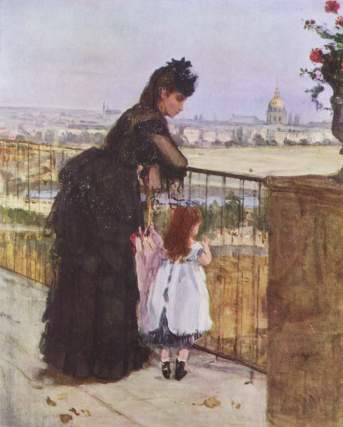Read PART I.
Read PART II.

Though numerous aspects of Morisot’s work are revolutionary in their rejection of earlier artistic traditions, her paintings still conform to the social norms set on women as illustrated through her appropriation of the settings used in fashion plates. By incorporating compositional and thematic elements of fashion plates into her paintings, Morisot’s paintings adopt the same attitude as fashion illustrations where women are associated with a suburban, upper-class lifestyle.i Morisot situates On the Balcony in Passy, where women adhered to strict rules regarding social conduct,ii and positions her figures within the domestic bourgeois role of mother and child in a promenade.iii On the Balcony and fashion illustrations, by focusing on women in domestic settings, construct a world where Parisian social life centered on the home.iv Morisot’s placement of her figures within the confines of Passy’s social rules emphasizes the extent to which she was informed by the socio-cultural setting that created fashion plates.v
Morisot’s adherence to society’s expectations of women extends beyond her inspiration from fashion plates’ settings to the positioning of the woman in On the Balcony in relation to the picture plane. Although nineteenth-century French society relegated upper-class women to the suburbs and the activities that Anne Higonnet terms the “feminine ritual”,vi women that worked within this system rose to positions of power, which is why Morisot did not need to join the budding feminist movement of the 1870s.vii Therefore, Morisot’s paintings do not criticize the situation of women at the time. Griselda Pollock argues that the women in Mary Cassatt’s Lydia at the Theatre and The Loge are at an angle with the picture plane and are not contained within the edges of the canvas, consequently not being made part of a framed spectacle for the viewer.viii Conversely, the woman in On the Balcony, reminiscent of the women in fashion plates, remains within the confines of the canvas and does not challenge her role as an object of the gaze. Like the women in fashion plates, Morisot’s woman and child are not active but immersed in observation, ignoring the spectators yet allowing themselves to become the visual spectacle.ix
In addition to the compositional placement of the woman in On the Balcony, Morisot does not deviate from societal norms and the dictates of fashion plates in terms of the clothing worn by the woman in her painting. Morisot paints “ladies”, who are beautiful yet introverted and reputable, not the sensual “fallen women” of the Paris nightlife.x The proper woman, according to both men and women in nineteenth-century France, was conservatively dressed and in a domestic location.xi The woman in On the Balcony, following this societal model often illustrated in fashion plates, is attractive and fashionable though respectably and modestly clothed, ultimately not highlighting her sexual attractiveness.xii Through this painting, Morisot conforms to her social sphere in Passy and perpetuates the image of the “proper woman” as respectable and maternal.
Morisot’s paintings, exemplified by On the Balcony, are informed by both fashion illustrations of nineteenth-century France and the society that created them. Morisot appropriates the composition, setting, and attitude of the fashion plate intoOn the Balcony to create a painting imbued with the fleeting nature of modernity. Her careful attention to the clothes of the mother and child in the painting emphasize Baudelaire’s equation of fashion to la vie moderne. Fashion plates often displayed beautiful, serene backgrounds of the Paris cityscape similar to the background in On the Balcony where Morisot erases the scars left byParis’ violent revolution and provides a socio-political model for peace. Morisot rebels against past artistic tradition through her adoption of the flat-patterned surface and arrangement of figures from fashion illustrations, combined with her fragmented brushstroke. Her brushstroke, the detailed background, and the balcony’s fence highlight the flatness of the canvas. Although Morisot challenged artistic traditions, she remained well within the bounds of her social setting and expectations as an upper-class woman in the nineteenth century. Much like those in fashion plates, the figures in her painting are respectably dressed and in a domestic setting, upholding the commonly held views regarding the “proper lady” at the time.
i. Higonnet, 106.
ii. Adler, 37.
iii. Schirrmeister, 108.
iv. Schirrmeister, 104.
v. Higonnet, 106.
vi. Higonnet, 108.
vii. Adler, 38.
viii. Pollock, 79.
ix. Higonnet, 111-112.
x. Pollock, 79.
xi. Higonnet, 65.
xii. Schirrmeister, 104.

